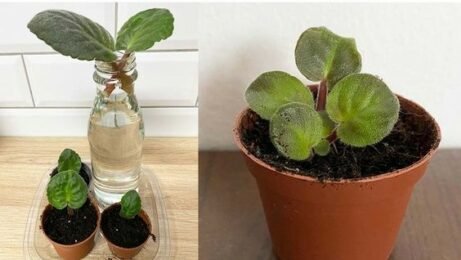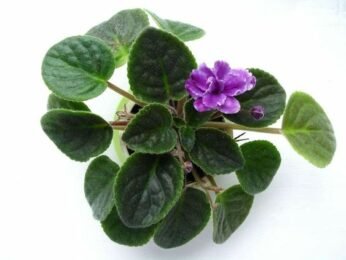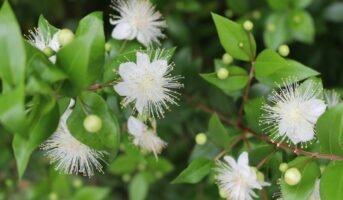What are African violets?
African violet, (genus Saintpaulia), comprises six species of flowering plants in the family Gesneriaceae endemic to higher elevations in equatorial eastern Africa. The African violet, more specifically the Streptocarpus ionanthus variety, is a popular houseplant that can flourish in low-light environments and continue to bloom throughout the year.
Horticulturalists have created hundreds of different species of plants, each with a unique flower colour and shape, including miniatures that are just half their normal size.

Source: Pinterest
see also: about African milk bush
African violet: Key facts
| Botanical name | Streptocarpus ionanthus |
| Family | Gesneriaceae |
| Maximum Height | upto 16 inches |
| Origin | Eastern tropical Africa |
| Temperature | Not suited to cold weather |
| Maintenance | low |
| Soil pH | 5.8-6.2 |
African violet: Features
- Saintpaulias can range in width from 6 to 30 centimetres, with its height ranging from 12 to 16 inches.
- The leaves are thick, coarsely hairy, and range in shape from round to oval. Their length ranges from 2.5 to 8.5 centimetres, while their petioles range from 2 to 10 centimetres.
- The blooms have a diameter of two to three centimetres, with five lobes on the corolla (also known as the “petals”) and grow in clusters of three to ten or more on thin stalks known as peduncles.
- Flowers of wild species may be white, pale blue, violet, or purple.
- Because of the plants’ superficial similarity to genuine violets, they are sometimes referred to by the popular term “African violet.”

Source: Pinterest
African violet: Growing tips
- As long as the soil has good drainage, you may use either a specific African violet potting mix or a general-purpose potting soil.
- African violets should be planted in tiny pots and repotted every few years to ensure that they receive fresh soil.
- Do not rush into giving African violets more room to grow, as this will cause them to produce fewer flowers.
- In addition to having a high organic matter content, the soil needs to have good drainage.
- When repotting African violets, you should avoid planting them any deeper than they were originally planted, and you should also be careful not to bury the plant’s crown.
- If the stems of African violets are allowed to become very damp, they may rot.
Propagating African Violets
You can propagate African Violets using cuttings of the leaf. Select a healthy leaf and cut it with sharp garden scissors such that there is stem of 1 or 2 inches attached. Fill a pot with siland and moist vermi content. Then place the leaf in the pot at an angle of 45 degrees and make the root medium around the leaves tight. Next water the leaves and let them drain properly. Cover the cuttings with a clear plastic bag and secure with a cello tape. Keep the pot in a brightly lit spot and you will have the roots coming in 4 weeks and leaves of the plant coming in 2 months.

Source: Pinterest
African violet: Maintenance tips
- Keep the soil wet, but not waterlogged. Only water the soil when it is apparent that it is lacking moisture. It is important to keep the leaves dry since getting them wet might result in permanent spots.
- They are able to function even under low light conditions, although they thrive in intense sunshine that is diffused.
- During the active growing season (spring and summer), fertilise your plant once every two weeks using a phosphorus-rich plant meal. Do not begin fertilising the plant until it seems like it might use a little additional help.
- Plants should be moved to larger pots as they mature but maintaining African violets in containers that are just a little too small for their roots might stimulate them to produce flowers. Wilted leaves are an indication that the violet you have needs to be repotted.
- Any kind does best in warm circumstances (at least 65 degrees Fahrenheit or 18 degrees Celsius); however, some can tolerate temperatures that are lower. In any event, throughout the winter months, you should keep them away from draughty windows.
Types of African violet
There are different types of African violet flowers. Some of them are namely:
- Amethyst: These flowers are pale purple in colour and are a single bloom.
- Crimson ice: These are flowers that are white in colour with parts of it in bright fuchsia.
- Diamond tiffany: In this type of African violet plant, the deep green leaves grow outside with semi-double ruffled white flowers in the centre.
- First Kiss Blush: This flower looks as if it’s blushing. The first kiss blush African plant has medium pink single flowers with purple freckles on them.
How to get African Violets to bloom?
African Violets bloom all year round. To make the African Violets bloom, place them in a place that is brightly lit indirect sunlight. Too less sunlight will make the plant stretch for sunlight and this will result in few or no flowers blooming. Too much sunlight will burn the African violet plant.

Source: Pinterest
African violet: Aesthetic benefits
The vivid colouration of the African violet makes this common houseplant a favourite among many people. Purple is frequently the first hue that springs to mind, but the complete variety of tones that may be achieved in this colour spans a wide spectrum. African violet house plants may be found in colours such as red, pink, white, indigo, and even blue, thanks to the efforts of enthusiastic botanists who have generated several hundred different types.
The colour is just one facet of the wide variation. You may discover African violets with a wide variety of leaf and blossom forms, as well as different combinations of the two. This enables you to fill your entire desk with jaw-droppingly talented members of the same family who are all stars in their own right.
African violet: Other uses
Research has proven that the colour purple, namely that of African violets, has positive effects on one’s health. When you stare at it, it helps trigger the release of a little amount of adrenaline, which enhances energy levels, and it also helps increase the flow of oxygen to your brain, which helps you relax. Both of these effects are beneficial. In addition, they do well when exposed to artificial light, making them an ideal plant choice for the workplace.
African violet: Toxicity
Houseplants of the African violet kind are completely safe for cats and dogs to interact with. Due to the high number of houseplants that are harmful to animals, pet safety should be one of your first considerations when selecting a plant species.

Source: Pinterest
Common problems with African Violets
- African violet leaves accumulate lot of dust.
- If there is not much light, then the African Violets refuse to bloom.
- If there is too much, the leaves of the African Violet become pale and gives a bleached look.
- Too much fertiliser causes the leaves to obtain a rust colour.
FAQs
Do African violets require full exposure to the sun?
In order to thrive, African violets require filtered light.
How many days can pass between waterings for African violets?
The African violet can survive for four to six weeks without any water.
What is the average lifespan of an African violet?
If they are given the proper care, African violets may survive for up to 50 years.
Housing News Desk is the news desk of leading online real estate portal, Housing.com. Housing News Desk focuses on a variety of topics such as real estate laws, taxes, current news, property trends, home loans, rentals, décor, green homes, home improvement, etc. The main objective of the news desk, is to cover the real estate sector from the perspective of providing information that is useful to the end-user.
Facebook: https://www.facebook.com/housing.com/
Twitter: https://twitter.com/Housing
Email: [email protected]











